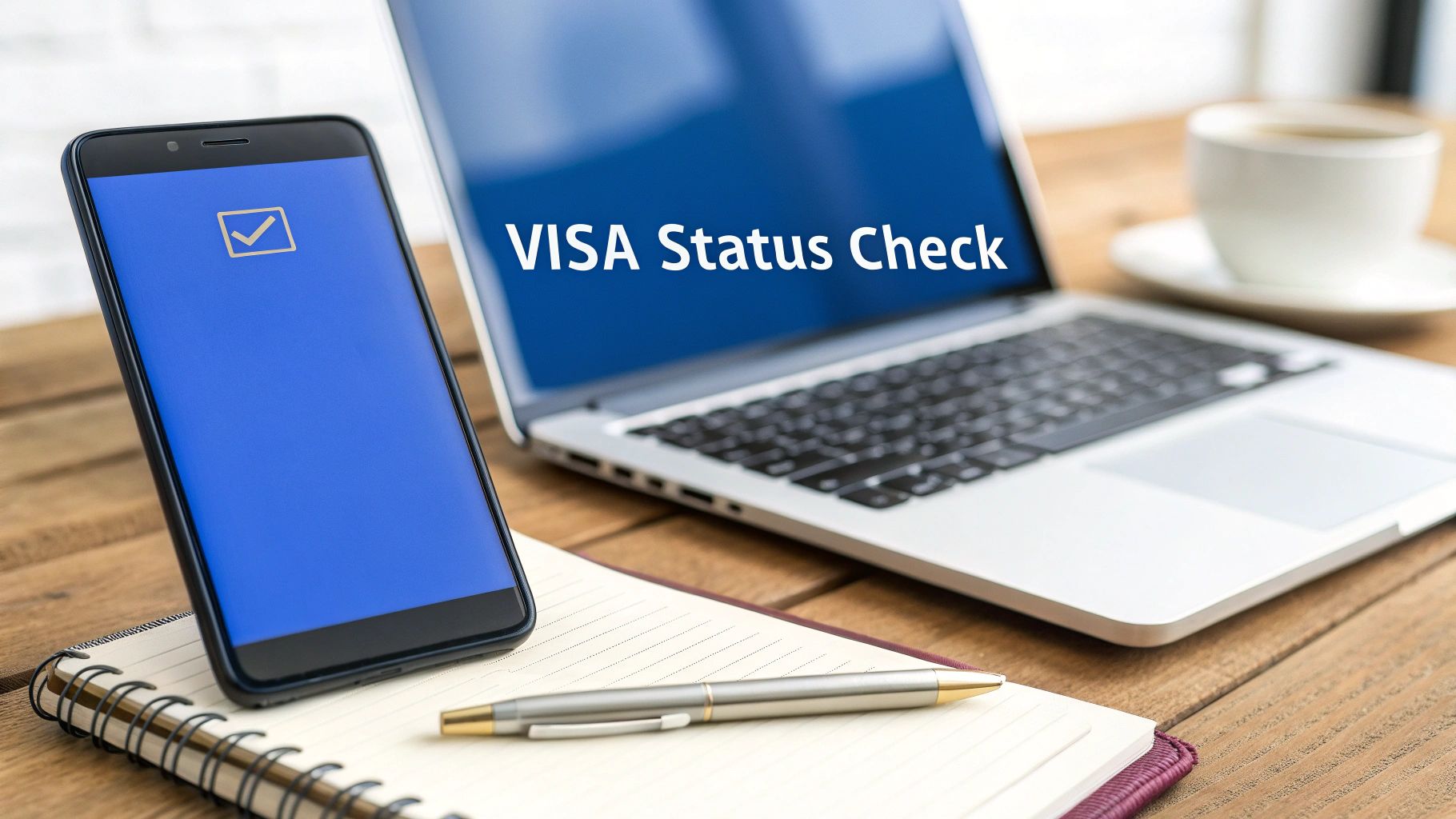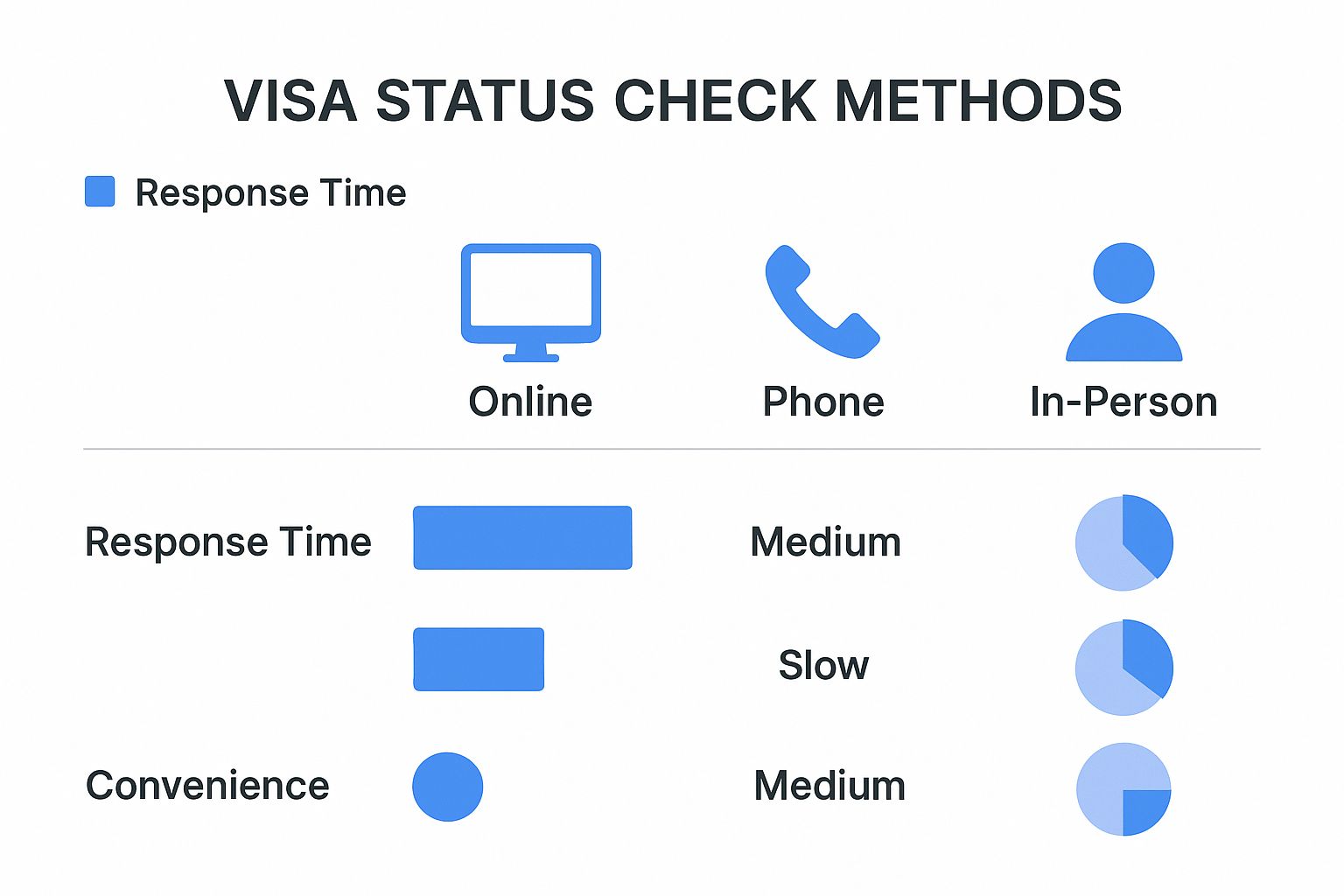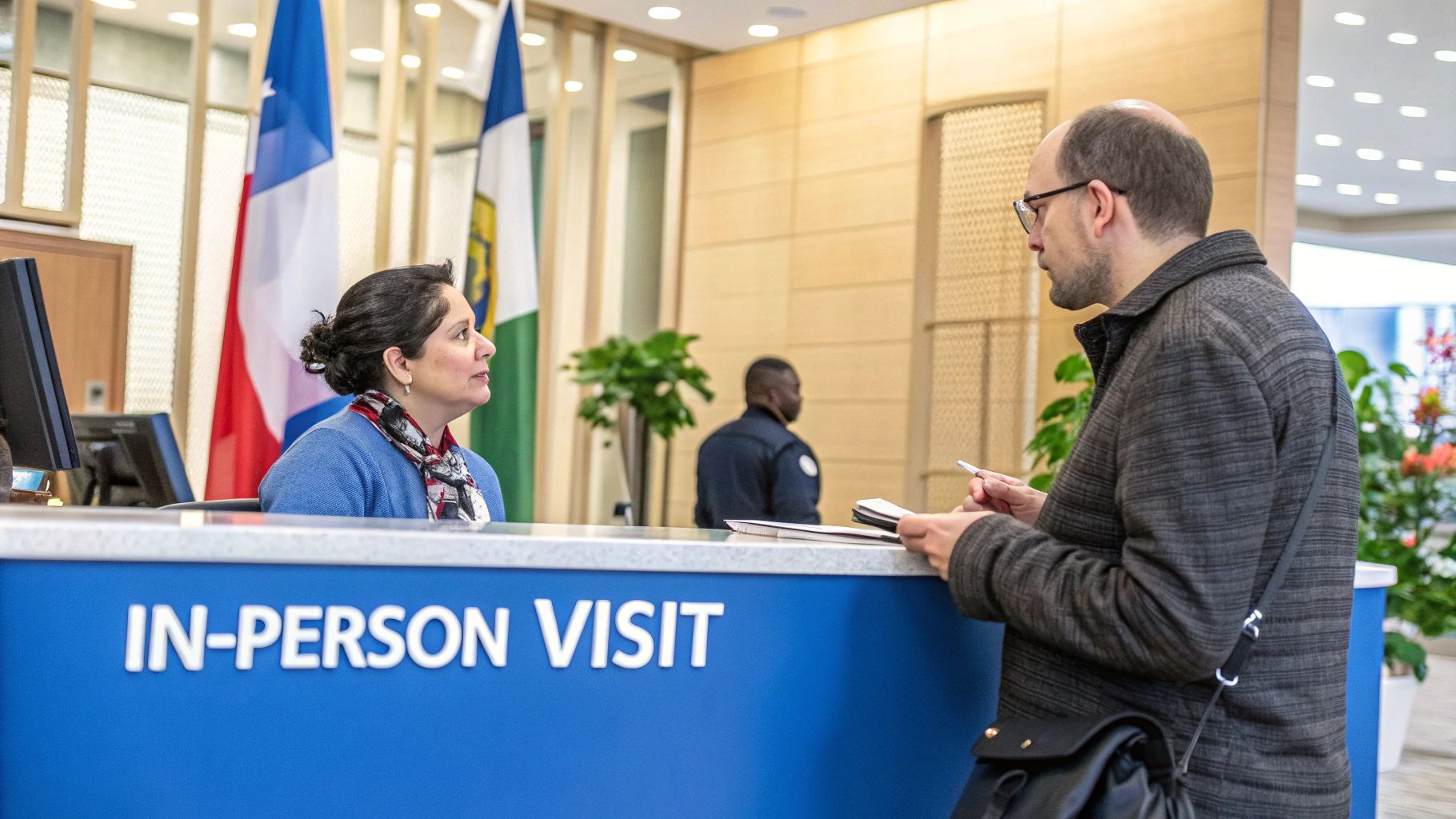How to Check Visa Status Easily & With Confidence

Let's be honest, the wait after submitting a visa application can be nerve-wracking. You’re left wondering, "What's happening?" but finding a clear answer isn't always simple. The good news is that you don't have to stay in the dark.
The most reliable way to get an update is by going straight to the source. This usually means using the official government or embassy portal with the unique application reference number you were given. You can also try contacting the consulate directly, though response times can vary.
Navigating Your Visa Status Check
This guide is designed to cut through that uncertainty and give you a clear, actionable plan for tracking your application's progress. We'll walk through the most common methods, from official online portals to specific embassy websites, so you can stop guessing and feel more in control.
Before we dive in, it’s worth noting that the tracking process is just one piece of the puzzle. For a broader look at managing your application from start to finish, our comprehensive guide on visa application tracking offers some great insights.
Now, let's break down the different ways you can check your status. The best method for you will depend on how quickly you need an answer and what information you have on hand.

As you can see, online portals are usually the quickest and most convenient option for getting an instant update.
Understanding Your Local Options
It’s crucial to remember that the process for checking your visa status can change a lot depending on the country.
For example, if you've applied through Nigeria, the Nigeria Immigration Service (NIS) has a modern, automated online system. This allows for real-time tracking directly on its official portal, which is a fantastic part of their move towards digital services.
The type of visa also matters. If you're looking for information on a specific application, like a renewal, you'll often find dedicated resources. This guide on how to check visa renewal status is a perfect example. Knowing exactly where to look for your specific visa type is half the battle.
Using Official Portals for Direct Updates
When it comes to your visa application, going straight to the source is always your best bet. Official government websites give you the most accurate, real-time information, so you can skip the guesswork and avoid delays from third-party services. For Nigerians, the main hub for this is the Nigeria Immigration Service (NIS) portal.
I know these official sites can sometimes feel a bit clunky or overwhelming, but they’re built to give you a direct line to your application's progress. The trick is to have the right information handy before you even start.
Finding Your Application Status
Before you do anything else, grab the receipt you were given when you submitted your application. You simply can't check your status without the details on it.
You'll need two key pieces of information:
- Application ID: This is the unique number assigned specifically to your visa application.
- Reference Number: Think of this as a second password to confirm your identity and pull up your file.
Treat these numbers like you would your bank details—keep them safe and private. Losing them will make tracking your application a real headache.
Here’s a look at what you can expect to see on the official Nigeria Immigration Service portal. This is where you’ll find the function to check your visa status.

The homepage is usually designed to be straightforward. Look for clear menu items like "Visa" or "Application Status"—these will take you exactly where you need to go.
Once you land on the right page, you'll see fields asking for your Application ID and Reference Number. Just type them in, hit submit, and the system will show you the current stage of your application.
My Personal Tip: Always, and I mean always, use the official government portal. The information you get is straight from the horse's mouth. It helps you avoid bad information and manage your expectations realistically. No one wants false hope or unnecessary panic.
The next step is understanding what the status update actually means. You might see common phrases like 'Submitted,' 'Under Review,' or 'Decision Made.' Each message marks a specific point in the processing journey, giving you a clear picture of where things stand without you having to pick up the phone or visit an office. This direct access puts you in control.
Checking Your Visa Status on Embassy and Consulate Websites
While national portals are brilliant for local matters, international visa applications are a whole different ball game. If you're applying for a visa to the United States, the United Kingdom, or a country in the Schengen Area, you’ll need to get familiar with their specific embassy or consulate websites. Each one has its own unique system.
For instance, anyone who's applied for a U.S. visa knows the Consular Electronic Application Center (CEAC). This is your go-to portal for tracking both non-immigrant and immigrant visa applications. All you need is your case number. It’s a world away from the Nigeria Immigration Service portal, so knowing which platform to use from the start is absolutely essential.
Understanding Different Country Systems
The truth is, there's no one-size-fits-all process. The UK, for example, relies heavily on third-party partners like VFS Global or TLScontact to manage the front end of their visa applications. This means your status update won't be on a government website, but on the portal of the company where you gave your biometrics.
Schengen visa applications follow a similar pattern—it all depends on which country's embassy you applied through. Some have their own dedicated tracking systems, while others push updates through their official visa application centres. A good habit I've learned over the years is to bookmark the correct tracking website the very moment you submit your application. It saves a lot of headaches later.
Staying on top of policy changes is non-negotiable. For example, recent shifts in visa reciprocity policies have directly affected Nigerian applicants. On July 8, 2025, a revised policy made most U.S. non-immigrant visas for Nigerians single-entry with a three-month validity. This is exactly why checking official embassy sites is so critical. You can read the full details in the official announcement on the U.S. Embassy in Nigeria's website.
Juggling these different platforms can feel overwhelming at first, but simply knowing which website to use is half the battle. If you want a broader look at all your options, our guide on how you can check your visa status offers some extra context. A little proactivity goes a long way in giving you peace of mind while you wait for that all-important decision.
Making Sense of Visa Statistics and Timelines
Waiting for a visa decision can be incredibly stressful, and it's easy to feel like you're in the dark. While you can't look up the exact status of your personal application in public data, you can get a feel for the bigger picture. Understanding these general trends is a smart way to manage your own expectations.

Think of it this way: you can't know for sure if it will rain during your picnic next Saturday, but checking the weather forecast gives you a pretty good idea. If there's a 90% chance of showers, you know to bring an umbrella. Visa statistics work in much the same way, giving you a sense of the current climate for applications like yours.
For instance, government agencies like the U.S. Department of State release regular reports on visa issuance. This is a goldmine of information, showing things like processing volumes, approval rates, and any backlogs affecting applicants from specific countries, including Nigeria.
Reading Between the Numbers
Having this context can bring a sense of control to an uncertain process. If you notice that processing times for your visa category have jumped by 20% in the last few months, a longer wait suddenly feels less personal and more like a systemic delay.
My two cents: Data gives you perspective, not a prediction for your specific case. High approval rates for a certain visa are great news, but they're no guarantee. Use these stats to stay informed, not to jump to conclusions about your own application.
You can usually find this data organised by:
- Visa Category: See how trends differ for student, work, or tourist visas.
- Country of Origin: Pinpoint statistics specifically for Nigerian applicants.
- Time Period: Check monthly or quarterly reports to see if new patterns are developing.
Since 2019, the U.S. has improved its visa data reporting, which is great news for Nigerian applicants. The new methods allow for more precise tracking as an application moves through the system. This transparency helps you get a clearer picture of decision timelines and approval trends.
You can dive into the data yourself by checking out the monthly immigration reports. In a journey that often feels out of your hands, knowledge is one of the most powerful tools you have.
Using Modern Tools to Simplify Your Search
Why spend your days manually refreshing multiple government websites? Let's be honest, it's exhausting and stressful, especially when you're navigating complex portals and aren't even sure what you're looking for. Technology has come a long way, and it’s completely changing how we can track visa applications, making the whole process feel much less like a black box.
Instead of wrestling with clunky government sites on your own, you can lean on services designed specifically to cut through the noise. These platforms pull updates from all the official sources and present them in one simple, clean dashboard. Imagine getting a single, clear notification the moment your status changes, rather than having to check five different websites every single day.
How AI-Powered Services Can Help
AI-powered platforms like JapaChat are built from the ground up to take this weight off your shoulders. They securely connect to official immigration databases, automatically fetch your latest status, and ping you with timely alerts right on your phone. This isn't just about saving time; it's about reducing the constant anxiety of the unknown.
Here’s what these tools really bring to the table:
- Time-Saving Automation: Forget manual checks. The service keeps an eye on your status 24/7.
- Consolidated Updates: All your information, from multiple official sources, gathered in one spot.
- Actionable Notifications: You get an immediate alert when something actually changes, so you never miss a critical update.
The real value here is the peace of mind. Knowing a system is tirelessly keeping watch for you frees up your mental energy. You can finally focus on other important parts of your relocation, like finding a place to live or packing.
For immigration professionals or anyone juggling multiple complex cases, looking into dedicated immigration case management software can offer even more robust features for tracking and organisation.
A quick word of advice: always put your data security first when choosing a service. A trustworthy platform will be upfront and transparent about how it protects your personal information while delivering the accurate updates you need. Using these modern solutions can truly transform visa tracking from a stressful chore into a simple, manageable task.
Common Questions About Visa Status Checks
Even with the clearest instructions, the visa application process can throw a few curveballs. It’s a journey filled with its own unique jargon and nail-biting moments. Let's walk through some of the most common questions people have when checking their visa status to give you a bit more peace of mind.

What Does Administrative Processing Mean?
Seeing the words "Administrative Processing" can make your heart sink, but don't panic. It's actually a very standard part of the process. All it means is that the consular office needs to take a closer look at your application, and this review goes beyond the usual timeframe. It doesn't signal a red flag.
This extra step could take just a few days or stretch into several weeks. While it's tempting to check the portal constantly, sending a flood of emails won't speed it up. Honestly, the best thing you can do is wait patiently for an update or for the embassy to request more information.
How Soon After My Interview Can I Check?
You’re eager for an update, I get it! A good rule of thumb is to wait about two to three business days after your interview before checking your status. This gives the consular officer enough time to log their decision and update the system properly.
Sometimes, you might get lucky and see an update the very next day. But checking too soon often just shows you old information, which can cause unnecessary stress. Give it a couple of days to be sure what you're seeing is current.
Can I Use Only My Passport Number to Check?
For most official portals, the answer is no. Your passport number alone isn't enough to pull up your visa status. Security and privacy are paramount, so systems like the U.S. CEAC portal or Nigeria's own NIS portal require a unique Application ID or Case/Reference Number.
This crucial number is usually on the confirmation page or receipt you got when you first submitted your application. I always tell people to treat that document like gold—it's your key to tracking your file.
While you wait, it’s vital to stay compliant with all visa requirements. For example, if you're applying for a U.S. student visa, you won't have direct access to the SEVIS immigration system—only your school's designated officials do. Your responsibility is simply to follow the rules, such as maintaining your full-time student status.
What If My Status Has Not Changed in Weeks?
Staring at the same status for weeks is incredibly frustrating, but it isn't always a cause for alarm. This is especially common during peak travel seasons or if your case is complex and requires a more thorough background check.
First, take a deep breath and double-check that you’re on the right website and have entered your details correctly. A simple typo can be the culprit. If the delay extends well beyond the average processing time for your specific visa category, then it's reasonable to contact the embassy or consulate through their official channels. Just be ready for a standard "it's still processing" reply if you're within the normal window.
If you're worried about a potential denial, it helps to be prepared. Take some time to understand the top visa rejection reasons and how to reapply.
Of course, the visa is just one piece of the puzzle. Settling into a new country brings its own set of financial challenges. For anyone needing a bit of guidance, this guide to financial literacy for immigrants is a fantastic resource.

Leave a Reply